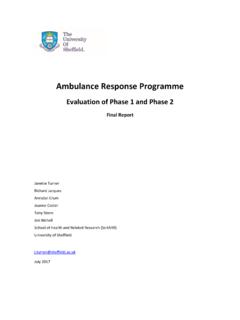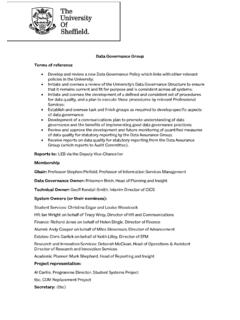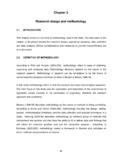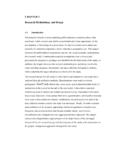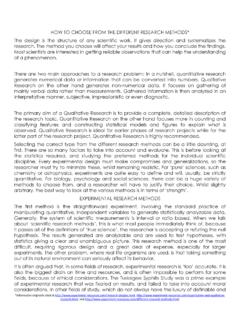Transcription of Chapter 7: Research design - The University of Sheffield
1 90 Chapter 7: Research design As stated in the introduction, the Research design adopted in this inquiry was primarily influenced by Guba and Lincoln s (1985) conception of Naturalistic Inquiry, which they later acknowledged was a form of Constructivism (Guba and Lincoln, 1998), and to a lesser extent Charmaz s (2006) constructivist conception of Grounded Theory. These are expanded upon in the next sections with reference to Crotty s (1998) four Research design elements. Decisions that were taken that influenced the Research design are woven into the narrative. Crotty s Research design elements Crotty claims that the terminology used in Research literature is confusing with epistemologies, theoretical perspectives, methodologies and methods thrown together in grab-bag style as if they were all comparable terms (Crotty, 1998:3).
2 Crotty suggests these terms represent distinct hierarchical levels of decision making within the Research design process. Paraphrasing, a researcher initially adopts a particular stance towards the nature of knowledge (for example, objectivism or subjectivism). This stance or epistemology will underlie the entire Research process and governs the particular theoretical perspective selected (for example, postpositivism or interpretivism). The theoretical perspective will be implicit in Research questions and dictate the researcher s choice of methodology (for example, grounded theory or ethnography). Finally, this methodology or plan of action will in turn inform the choice of Research methods employed (for example, questionnaires or interviews).
3 Crotty (1998) recognises that he omits ontology from the Research process but conflates it with epistemology claiming the two are mutually dependent and difficult to distinguish conceptually when discussing Research issues: to talk about the construction of meaning [epistemology] is to talk of the construction of a meaningful reality [ontology] (Crotty, 1998:10). Creswell (2003), who bases his Research process framework on Crotty s (1998) four Research design elements, implies that these four decision making elements lead to a Research approach which tends to be more quantitative, qualitative or mixed, primarily dependent on the researcher s initial stance towards the nature of knowledge. 91 Epistemology Epistemology is about how we know what we know (Crotty, 1998:8) or the nature of the relationship between the knower or would-be knower and what can be known (Guba and Lincoln, 1998:201).
4 Epistemology is concerned with providing a philosophical grounding for deciding what kinds of knowledge are possible and how we ensure it is adequate and legitimate (Maynard, 1994). It is related to ontology, the study of being (Crotty, 1998:10) or The nature of reality (Lincoln and Guba, 1985:37). Crotty (1998) notes that an ontological stance implies a particular epistemological stance and vice versa. He highlights the complementary nature of the terms when he cites the ontological notion of realism, which postulates that realities exist outside of the mind, and its complement objectivism, an epistemological notion asserting that meaning exists in objects independent of any consciousness; if one stance is adopted, so its complement.
5 Guba and Lincoln (1998) state that constructivist Research is relativist, transactional and subjectivist. Adopting a relativist stance means there is no objective truth to be known (Hugly and Sayward, 1987:278) and emphasises the diversity of interpretations that can be applied to the world. Transactional means that truth arises from interactions between elements of some rhetorical situation (Berlin, 1987), and is the product these interactions and the individuals thoughts ( constructed realities ). Subjectivist Research positions the world, including the psychological world of Research participants, as unknowable and the role of the researcher is to construct an impression of the world as they see it (Ratner, 2008).
6 It follows that conventional distinctions between epistemological and ontological viewpoints disappear in constructivist Research as the investigator and the object of investigation are .. interactively linked so that the findings are literally created as the investigation proceeds (Lincoln and Guba, 1985:207). The epistemological and ontological stance adopted in constructivist Research thus differs from a more realist ontology and objectivist epistemology underlying popular conceptions of Grounded Theory (for example, Glaser and Strauss, 1967; Strauss and Corbin, 1998), where the investigator s role is to discover the truth that lies within the object of investigation, with reality existing independently of any consciousness (Crotty, 1998; Charmaz, 2006).
7 Data are assumed to be objective facts that already exist in the world, and the role of the researcher is to discover these data and determine the theories they imply (Charmaz, 2006). However, Charmaz s (2006) Grounded Theory 92 Research design is consistent with a constructivist epistemology and ontology by placing priority on the phenomena of study and seeing both data and analysis as created from shared experiences and relationships with participants and other sources (Charmaz, 2006:330) claiming that a more objectivist approach diminishes the power of a constructivist approach by treating experience as separate, fragmented and atomistic (Charmaz, 2006:331). For Research that claims to be relativist, transactional and subjectivist, the above analysis has several implications: Firstly, social Research produces multiple constructed realities that can be studied holistically; inquiry into these multiple realities will inevitably diverge (each inquiry raises more questions than it answers) (Lincoln and Guba, 1985:37).
8 Secondly, humans should be the primary data collection instrument (Lincoln and Guba, 1985) since it is difficult to envisage non-human instruments that could interact with participants in a way that would reveal their multiple constructed realities. Thirdly, as the knower and the known are inseparable (Lincoln and Guba, 1985:37) the Research participants should be a natural setting (for example, the context related to the study) since their realities are wholes that cannot be understood in isolation from their contexts (Lincoln and Guba, 1985:39). Fourthly, as every act of observation influences what is seen (Lincoln and Guba, 1985:39), the researcher has to be the primary data-gathering instrument to fully understand, respond and describe the complex interactions taking place.
9 Fifthly, as each Research participant has their own point of view, the focus of Research is on the identification of contextualised meaning of these multiple points of view (Green, 2000) with the goal of creating a joint, collaborative reconstruction from the multiple realities that exist (Guba and Lincoln, 1989b). This implies that the Research participants have a co-producer role in the Research process and have a role in negotiating outcomes. Implications for this Research For this Research I was the sole investigator ( human instrument ) who interacted with all participants. I was thus more able to realise, and holistic study, all students and academics constructed realities. As one of the undergraduates teachers and a colleague of all the academics, it seemed appropriate to conduct the Research information collection within my school where most teaching takes place and where all but one academic29 has their office.
10 The subsequent analysis of information 29 Academic 01 had an office in one of the University s libraries 93 collected formed a tentative reconstruction from the multiple realities that existed at the time the information was collected. Not withstanding the temporal and contextual nature of the information collected, this was presented to participants for comment with the aim that some dialogue might ensue, and the collaborative reconstruction of the multiple realities revealed by my original analysis might evolve in the light of new insights and clarification of views expressed. Research theoretical perspective Crotty defines the theoretical perspective of his Research design framework as The philosophical stance informing the methodology (Crotty, 1998:3) and claims there are potentially many theoretical Research perspectives that result from particular epistemological and ontological stances.






